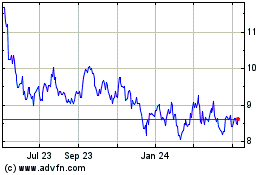Vodafone Supercharges Its Procurement With Automation, AI
June 28 2019 - 5:59AM
Dow Jones News
By Tatyana Shumsky
Vodafone Group PLC turned to a suite of new technologies,
including data-visualization tools and artificial intelligence, to
make its global procurement process faster and less expensive.
The British telecommunications giant's procurement unit issues
about 800,000 purchase orders and receives around 5 million
invoices a year as its 23 operating companies, including in Egypt
and New Zealand, requisition everything from magazine advertising
to antennas.
But tracking and analyzing the effectiveness of these buying
practices hasn't always been easy. Back in 2015, a team of roughly
10 people, plus another five members of the shared service center
staff, would spend three to four weeks compiling data about the
prior month's purchase orders, approval rates and times, and other
trends.
"We were getting very frustrated," said Ninian Wilson, chief
executive of Vodafone Procurement Co. "By the time we'd have
everything ready, the information was already four weeks out of
date and it was time to start collecting it all over again."
The difficulty in collating the necessary figures, and the high
rate of errors introduced by the extremely manual collection
process, meant that the team had little time to analyze the data
and make recommendations for improvement, Mr. Wilson said.
To fix the problem, Vodafone decided to build a
supply-chain-analytics control center to measure efficiency and
compliance metrics across its procurement function. The company
also hired data scientists to help select key performance
indicators and present that information visually to a broad range
of users.
The project took nine months. The newly built control center
includes a platform that analyzes 20 terabytes of data, or roughly
two years of transactions, and a visualization tool that allows the
roughly 750 users across the company spot trends and track
performance on a desktop made up of speedometers. The system also
relies on robotic process automation to simplify a variety of tasks
as well as artificial intelligence and machine learning to identify
patterns and boost predictive modeling.
Vodafone is one of many companies that are on the second
iteration of digital transformation, where companies use a mix of
new technologies to tackle increasingly complex problems, said Vin
Kumar, associate principal at consulting firm Hackett Group.
"One tool by itself is not doing it," Mr. Kumar said. "You have
to use a combination of technology to provide this insight," he
said, adding that some of the bigger technology vendors are already
trying to integrate these tools.
Vodafone Procurement now has a team of six data scientists
managing the platform, while the procurement staff members who
previously collected this information have been reassigned to
higher-value-added tasks such as strategic sourcing and
negotiations, Mr. Wilson said.
Today, Mr. Wilson can track nearly in real time a purchase order
that's moving through the system, from when a requisition is raised
by an employee in New Zealand to when the purchase order is
approved to when the invoice payment is issued.
Efficiency metrics are also at his fingertips, according to Mr.
Wilson. Before the new system was installed, roughly 73% of
Vodafone's purchase orders were perfect, requiring no adjustments
or rework to move through the system. In the year through June 27,
the company had a perfect purchase order rate of 96%.
The improved visibility and speed of analysis mean Vodafone has
also improved on cost. The cost per purchase order was EUR2.7
($3.07) in April 2017, before the system was installed; it is
currently EUR2.36 per purchase order.
"That's a huge improvement," Mr. Wilson said. But the team isn't
resting on its laurels and aims to get the cost per purchase order
below EUR1 by April 2021, he said.
Vodafone declined to comment on how much the system cost, but
representatives said it took roughly a year to recoup that
investment.
The team can assign the 800,000 orders made each year to
categories such as operating company or individual department or
person who raised the requisition.
The new system helps identify potential bottlenecks in the
procurement process, allowing his team to apply additional
standardization and automation when necessary to accelerate the
process. That specificity helps the team uncover process
inefficiencies that, once resolved, reduce time to market by 20%
and cut procurement process costs by 11%.
"We have a very granular view of the data, which we just
couldn't get to before we implemented this capability," Mr. Wilson
said.
Vodafone can also track which business units are on target and
which have room to improve across all the different efficiency
measures the company monitors. And since the system links all
countries to the same data, "If we say Italian performance is 95%,
there's no discussion because there's one source of truth," Mr.
Wilson said.
Write to Tatyana Shumsky at tatyana.shumsky@wsj.com
(END) Dow Jones Newswires
June 28, 2019 05:44 ET (09:44 GMT)
Copyright (c) 2019 Dow Jones & Company, Inc.
Vodafone (NASDAQ:VOD)
Historical Stock Chart
From Mar 2024 to Apr 2024

Vodafone (NASDAQ:VOD)
Historical Stock Chart
From Apr 2023 to Apr 2024
